|
 |
If you visit our forums, you might have noticed that we mention the word restoration from time to time. You might have wondered why we keep bringing this up instead of just calling it scanning a magazine. Well it certainly isn't a word we throw around lightly.
Besides being a preservation site, we also take pride in the fact that we do everything in our power to actually restore classic magazines to their former glory. This process is similar to how movies from the 50's and 60's are being restored from prints that have aged badly, at least the visual parts.
It also explains why it can take up to 30 to 40 hours to finish a single 100 page magazine from start to finish. Those numbers might sound exaggerated when you think about it, but we can assure you they are not.
With this feature we are about to give you a peek of what goes on behind the scenes of Out of Print Archive and how we spend endless hours on creating the best possible digital renditions of your most beloved classic video game magazines out there for everyone to enjoy once again. |
The first basic step that you need to do when creating a digital version of a magazine is, naturally, to scan in the pages. Seems simple enough doesn't it?
Well there's quite a bit that can go wrong along the way.
Your scanner plate might be too small to accommodate the full size of the magazine. Or when you scan in your pages, the inside strip of the magazine can come out blurred due to the spine of the magazine getting in the way.
As you can see from the image below, we get around these problems by scanning every single page up to 4 times and then putting all the pieces back together to create the best possible rendition of the original page without losing anything in the process. |
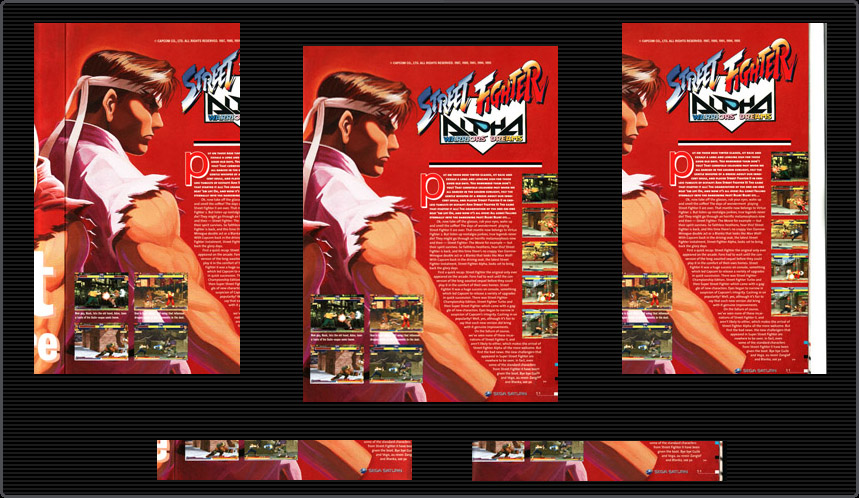 |
The restoration part itself is a lot more complex.
What it basically comes down to is that we need to adapt to the need of every individual page in order to return it to its former glory.
Sometimes these interventions are very small and can be done in a couple of minutes depending on the level of damage the page has received over its lifetime.
At other times, more drastic steps need to be taken in order to get certain pages back to the level of quality that we tend to set for ourselves.
In here, we will try to illustrate with the help of a couple of examples just how we can spend upwards of 6 hours on a single page to get it just right.
Luckily, we don't run into those instances on a weekly basis, but still, they do happen more often then you would think. And certainly more often than we would hope for.
Since the finished magazines you find on the site don't show any insight into the original state of the magazines before we started scanning them, we thought it might be interesting give you a peek at just how extensive the work is that goes into them before they are ready to go live on the site. |
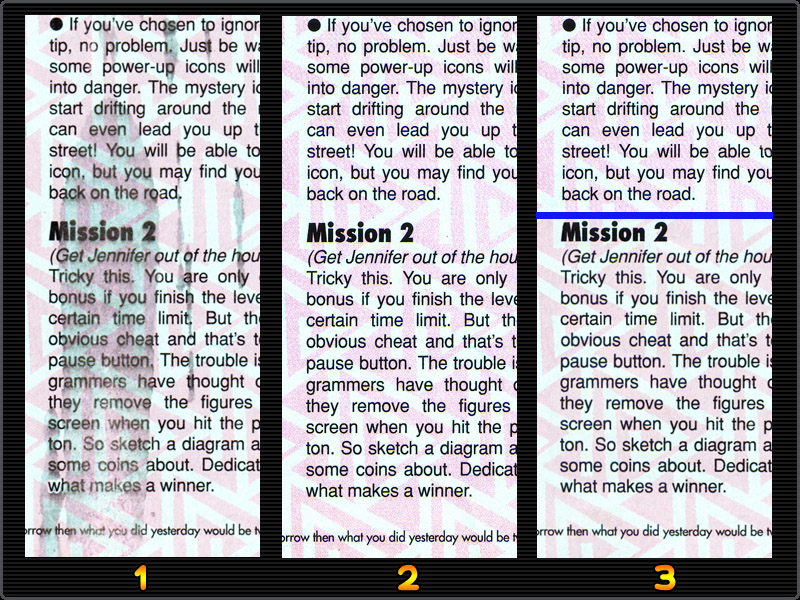 |
As you can see in image 1 of page 72 of Sega Pro issue 2, the first impression you'll get is that this page looks like a total loss. Nothing can be done to save it, besides looking for another physical issue and hoping that it doesn't have the same problem.
But that can be a costly gamble that doesn't always pay off, even in the event that you actually do come across another issue in good overall condition.
We found this out the hard way over the years and a good friend of ours, Andynick can attest to this when he scanned this very page of his personal copy and noticed how it also had this problem, although not in the exact same spots.
So we had a huge problem on our hands.
As luck would have it, another good friend, Homgran, had a copy that didn't suffer from this bad print run and scanned in the pages needed.
But we feared from having done experiments in the past, that we'd have a case of "Frankensteining" on our hands.
This pretty much means that every single scanner likes to do things in its own way. Combine this with the various image manipulation programs and how they save images, no two scans will look the exact same way unless they are done on the same hardware and software combo, along with identical settings. This is illustrated in image number 2 as well as image number 3 where you can clearly see the difference in grain and sharpness as well as color tones.
So simply replacing our own page number 72 with this one wasn't an option.
We could always have this magazine sent over to do a scan on the original setup, but that would mean running into possible problems such as the expenses to have the magazine shipped back and forth as well as it being damaged in the mail, or worse, going missing. Which certainly wasn't an option.
|
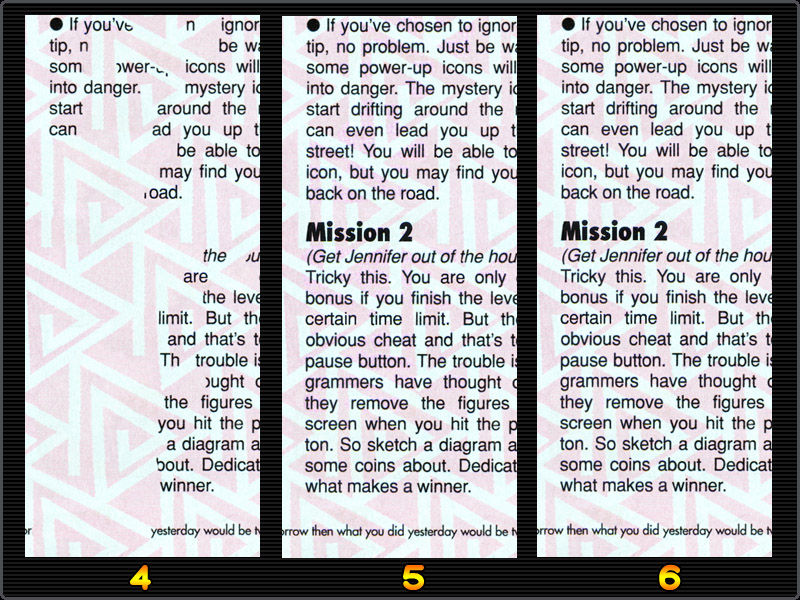 |
So we needed to find a different solution.
We found one as you can see in image number 4, by removing the damaged sections of the page and reconstructing the background imagery piece by piece.
From there we took the text of Homgran's scan and put this one into our original one by playing around with the layers as well as a variety of other settings a bit. The image below gives a better look at the problematic nature of merging these two together like this.
So the final step was taking the eraser tool and removing every single pixel of the new page that wasn't part of the text itself, so that the background on the underlaying layer would come through and the page would look like nothing ever happened to it.
The end result can be seen in image number 6.
After all is said and done, this page took over 6 hours to complete and was done so over the course of several days. In the end, we think it was worth it.
|
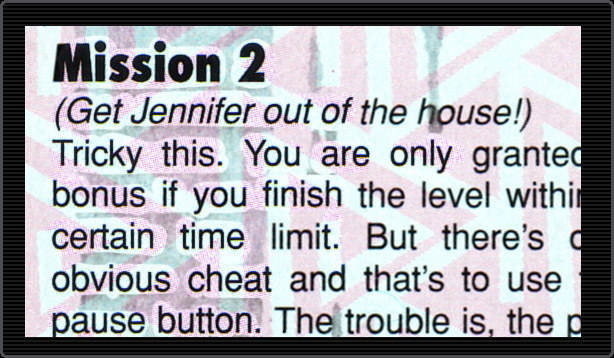 |
This one example above is just one of many things that we encounter when creating digital renditions of magazines that are at least 10 years old.
Going into details about each and every one of these problems would be so time consuming that it would take even longer to release magazines. But we hope that this feature has at least given you an idea of why we aren't putting out 5 magazines per week.
Doing so would mean that we'd have to make huge compromises when it comes to quality versus quality, and to be frank, we aren't willing to do that.
To finish off we have collected several more examples of the work that is put into each and every single magazine that we bring you.
|
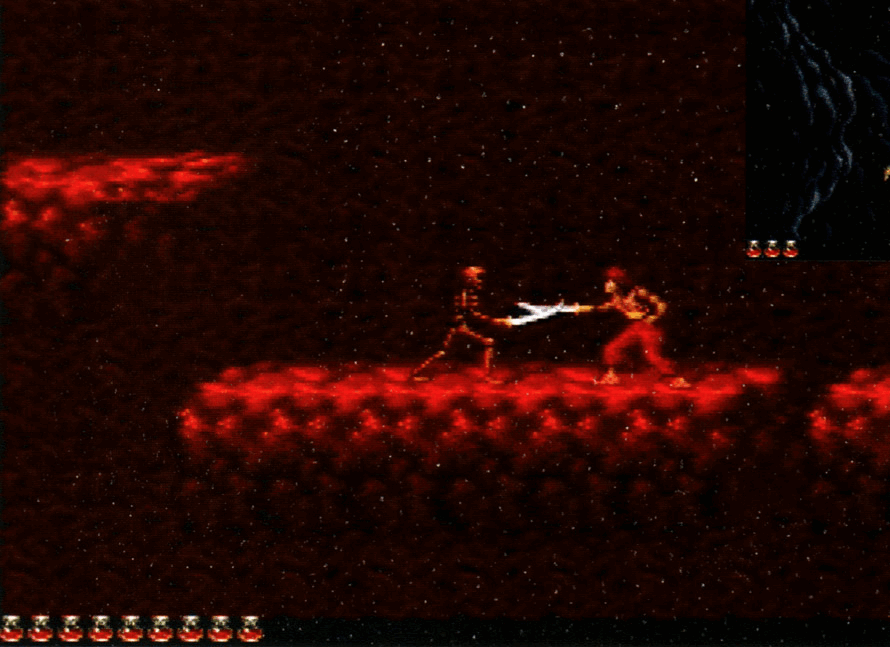 |
 |
 |
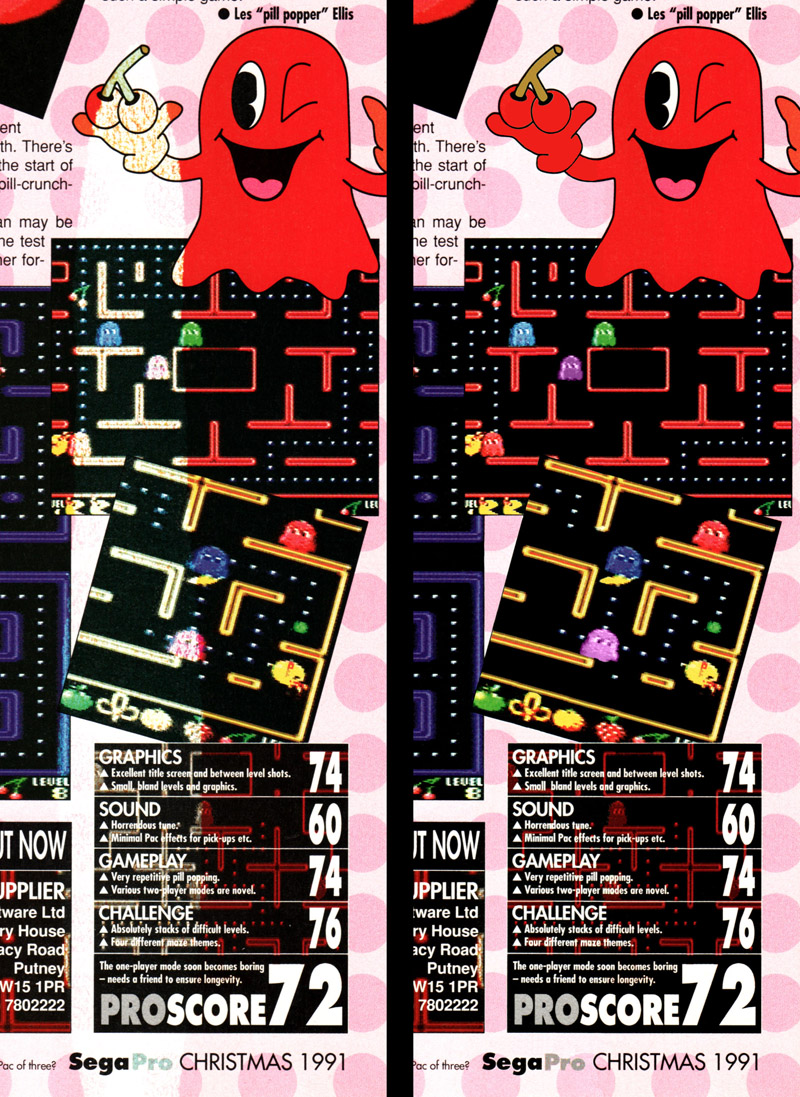 |
The following example is one of the hardest issues we've faced to this day. Our issue of Sega Pro 4 was in excellent condition except for this one page. Now normally damage can be quite extensive and still be fixed up if you throw enough time at it.
In this case however, we felt that due to the damage taking up more than 50% of the page as well as the the kind of damage it was, it would be nearly impossible to restore this page in a satisfactory way. So we decided to look for a new copy of Sega Pro issue 4. Many months went by after we released issue 3 of Sega Pro in February of 2012, but still we weren't able to find a replacement issue. Since it was taking so long, we decided to skip issue 4 until the day came that we found a mint copy and released issue 5 in September of 2012 instead.
As of this writing, it's March of 2013 and we still haven't found a replacement copy.
So we only had two options. Release issue 4 with the damaged page as is, hoping to one day find a new issue and replace the page, or take on the momentous task of restoring this page with painstaking detail.
As we are not known for releasing sub-par works ourselves, the first option wasn't even up for consideration.
So the work started. And after more than 14 hours of dedication and drive to do the original work justice, not to mention a lot of editing work with a brush no larger than 2 pixels by 2 pixels for all of the text restoration, we believe that we have succeeded in our goal. For a more detailed view, you can click on the image below. |
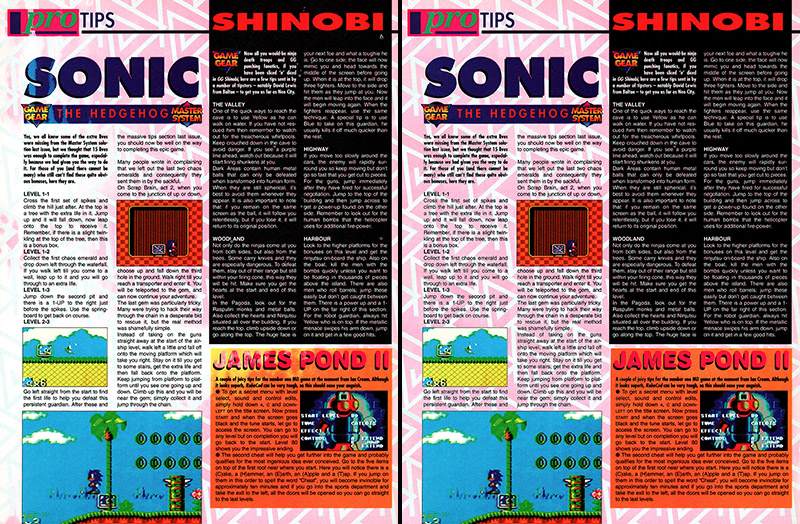 |
The final three GIFs are rather large, so instead of putting them up on this page, you can view them by clicking the thumbnails below.
Please do keep in mind that due to the GIF format you might notice quite a bit of artifacting which doesn't apear in the final jpg files inside the magazines.
The GIF format isn't really suited for these kinds of detailed images, but nonetheless it's a good way to compare the before and after shots.
To view the final result, please check out the complete issue in its full resolution.
All these issues and many more can be found in the magazine catalogue, except for the GameFan issues, which should be
available for purchase on the official GameFan Magazine website in the near future. |
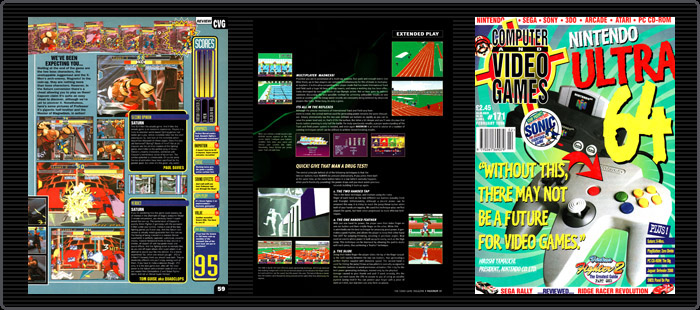 |
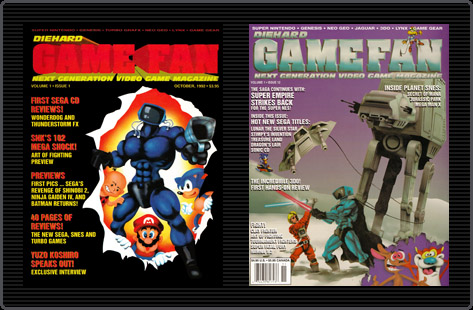 |
It's been a while since I added a new example of magazine restorations to this page, but the following one certainly qualifies as one of the most time consuming restorations alongside the Sega Pro page from above.
I was able to complete my set of Club Nintendo magazines in 2017 thanks to a generous person who donated the last two issues of this magazine as I bought several others from him. The only problem with this was that they were in very bad shape. Not only was there the normal wear and tear that one might expect from a magazine that's nearly 30 years old, but it had also been taped back together, and the glue from this tape has become yellow over the years.
I didn't know if it would be possible to restore the pages back to their former glory, but I gave it a try anyway.
In the end it took more time to resurrect these 20 pages than it normally takes a regular 100 page magazine in good condition.
But the end result speaks for itself and another hard to find magazine is now finally preserved.
Be sure to click on the examples below to get a look behind the courtains as we show you the untouched pages right next to the fully restored ones. |
|
Another example is this cover page from N64 Magazine 10 - January 1998 (UK).
Since the cover is reflective silver, it doesn't scan very well.
Instead it comes out looking more brown than silver.
But after spending over 6 hours of painstakingly replacing the background pixel by pixel, it now looks really close to how the actual magazine looks in real time. |
And some more exaples of various issues and problems that I run into when scanning and preserving magazines: |
These are some examples of the work that has been done on the Complete Guide To Consoles 2: |
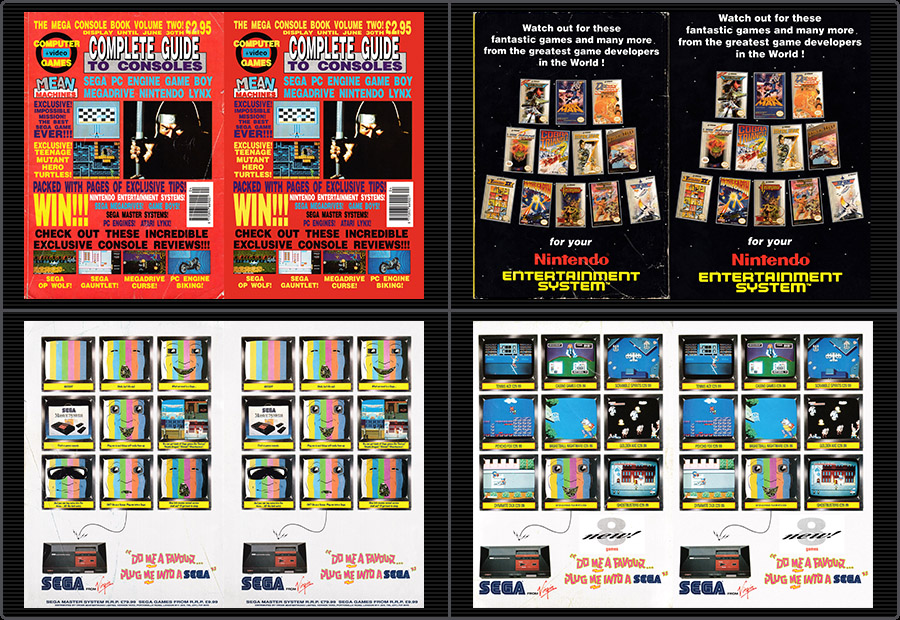 |
One of the latest examples of this process comes from Official Nintendo Magazine 27 - March 2008 (UK), where a single page had to be removed from the magazine before shipping it out.
From everything I have gathered, this was due to a misprint of the advertisement on page 43.
This PSP advert was not supposed to be in the magazine due to the licensing deal with Nintendo. Since this was the Official Nintendo Magazine after all.
It could only contain Nintendo advertisements in it, and thus this particular page needed to be removed, but since it was too late in the printing process, it was torn out of the magazines manually.
This meant that everyone who received this issue was left without page 43 and 44, my copy included.
I even ordered a second copy earlier this year as I didn't know of this at the time I scanned it.
Needless to say, this second copy, despite being in mint condition also had this page missing.
Identifying and locating the missing advertisement page was relatively simple.
The other side was anything but...
It looks like at the time, subscribers received an email telling them why the page was missing and directed them to a link to download a "hi-res JPEG" of the page in question.
16 years onwards and we can see how this page is anything but "hi-res" today.
And thus began my quest to reconstruct this page from zero, with just this low quality, highly compressed, tiny digital image as a guide to how the actual page
originally looked.
Click below on the comparison page where you can see just how small this original page was, compared to the one that ended up in the magazine release you can grab from this site.
While I have done some truly extensive restoration work on magazines over the past 15 years,
this one is without a doubt the hardest one I had to do, but I'm really happy with the result.
Click on the image below to be taken to the detailed showcase of how the process evolved as well as quite a few examples of before and after images.
Enjoy!
|
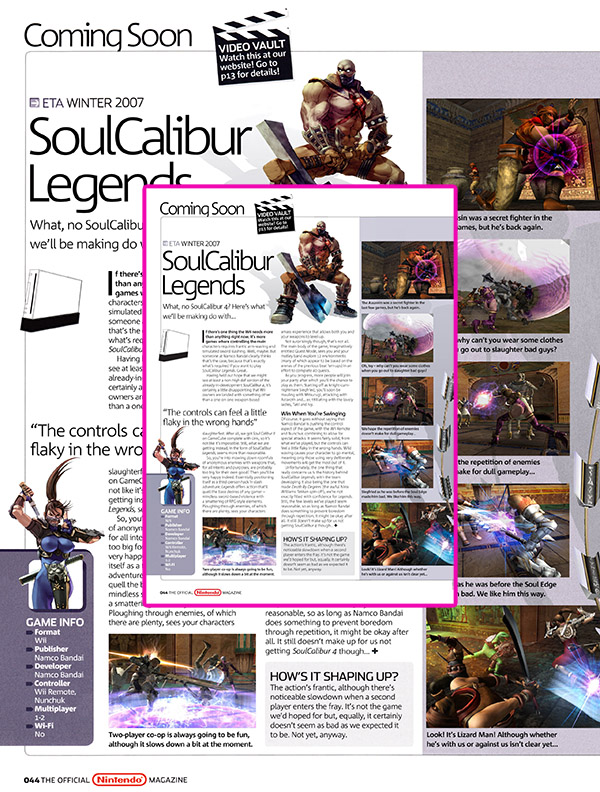 |
|
|
|